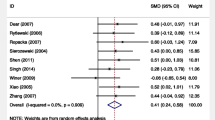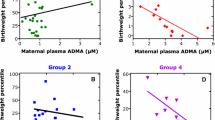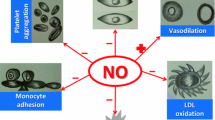Abstract
The current management of intrauterine growth restriction (IUGR) being empirical and aimed at selecting a safe time for delivery. Acknowledging the beneficial effects of l-arginine on endothelial vasculature the present study was designed to evaluate efficacy of l-arginine on bioavailability of nitric oxide (NO) with respect to fetal outcome. With l-arginine supplementation, mean NO levels were significantly increased and a significant mild reduction in systolic/end-diastolic velocity ratio (S/D ratio) was observed on doppler blood flow study, also neonatal outcome improved and incidences of complications were lowered. A deficiency in NO may play an important role in the causation of asymmetric fetal growth restriction. l-Arginine can be used to increase maternal NO levels, enhancing birth weight and decreasing neonatal morbidity. The ideal candidate for arginine therapy according to our study would be IUGR cases with S/D ratio less than 4.96 ± 0.49 and NO levels below 33 μmol/L with minimum of 3 weeks duration of arginine supplementation.


Similar content being viewed by others
References
Divon MY, Hsu HW. Maternal and fetal blood flow velocity waveforms in intrauterine growth retardation. Clin Obstet Gynecol. 1992;35:156–71.
Biswas R, Dasgupta A, Sinha RN, Chauduhri RN. An epidemiological study of low birth weight newborns in the district of Puruliya, West Bengal. Indian J Public Health. 2008;52(2):65–71.
Gluckman PD, Hanson MA. The consequences of being born small: an adaptive perspective. Horm Res. 2006;65:5–14.
Mari G, Hanif F. Intrauterine growth restriction: how to manage and when to deliver. Clin Obstet Gynecol. 2007;50:497–509.
Sankaran S, Kyle PM. Aetiology and pathogenesis of IUGR. Best Pract Res Clin Obstet Gynaecol. 2009;23(6):765–77.
Kusinski LC, Stanley JL, Dilworth MR, Hirt CJ, Andersson IJ, Renshall LJ, et al. eNOS knockout mouse as a model of fetal growth restriction with an impaired uterine artery function and placental transport phenotype. Am J Physiol Regul Integr Comp Physiol. 2012;303(1):86–93.
Lyall F, Greer IA, Young A, Myatt L. Nitric oxide concentrations are increased in fetoplacental circulation in intrauterine growth restriction. Placenta. 1996;17:165–8.
Redman CWG, Sacks GP, Sargent IL. Preeclampsia: an excessive maternal inflammatory response to pregnancy. Am J Obs Gynecol. 1999;180:499–506.
Resnik R. Intrauterine growth restriction. Obstet Gynecol. 2002;99:490–6.
Wu G, Bazer FW, Davis TA, Kim SW, Li P, MarcRhoads J, et al. Arginine metabolism and nutrition in growth, health and disease. Amino Acids. 2009;37:153–68.
Wu G, Morris SM Jr. Arginine metabolism: nitric oxide and beyond. Biochem J. 1998;336:1–17.
Wu G, Bazer FW, Wallace JM, Spencer TE. Board-invited review intrauterine growth retardation: implications for the animal sciences. J Anim Sci. 2006;84:2316–37.
Grisham MB, Johnson GG, Lancaster JR Jr. Quantitation of nitrite and nitrate in extra-cellular fluids. Methods Enzymol. 1996;268:237–46.
Xu K, Dong M, Zhou J. Changes of maternal and umbilical serum nitric oxide in patients with the intrauterine growth retardation. Zhonghua Fu Chan Ke Za Zhi. 2000;35(12):715–6.
Schiessl B, Strasburger C, Bidlingmaier M, Mylonas I, Jeschke U, Kainer F, et al. Plasma and urine concentrations of nitrite/nitrate and cyclic GMP in intrauterine growth restricted and preeclamptic pregnancies. Arch Gynecol Obstet. 2006;274:150–4.
Neri I, Mazza V, Galassi MC, Volpe A, Facchinetti F. Effects of L-arginine on utero-placental circulation in growth retarded fetuses. Acta Obstet Gynecol Scand. 1996;75:208–12.
Thureen PJ, Baron KA, Fennessey PV, Hay WW Jr. Ovine placental and fetal arginine and metabolism at normal and increased maternal plasma arginine concentrations. Peads Res. 2002;51:464–71.
Montagnani M, Chen H, Barr VA, Quon MJ. Insulin-stimulated activation of eNOS is independent of Ca2+ but requires phosphorylation by Akt at Ser1179. J Biol Chem. 2001;276:30392–8.
Lakhkar BN, Rajagopal KN, Gaurishankar PT. Doppler prediction of adverse perinatal outcome in PIH and IUGR. Indian J Radiol Imag. 2006;16(1):109–16.
Roy A, Mukherjee S, Bhattacharyya SK, Banerjee P, Das B, Patra KK. Perinatal outcome in pregnancies with intra-uterine growth restriction by using umbilical and middle cerebral artery colour Doppler. J Indian Med Assoc. 2012;110(3):154–7.
Xiao XM, Li LP. L-arginine treatment for asymmetric fetal growth restriction. Int J Gynecol Obstet. 2005;88(1):15–8.
Lampariello C, De Blasio A, Merenda A, Graziano E, Michalopoulou A, Bruno P. Use of L-arginine in intrauterine growth retardation (IUGR): authors’ experience. Minerva Ginecol. 1997;49:577–81.
Winer N, Branger B, Azria E, Tsatsaris V, Philippe HJ, Rozé JC, et al. L-arginine treatment for severe vascular fetal intrauterine growth restriction: a randomized double-bind controlled trial. Clin Nutr. 2009;28(3):243–8.
Author information
Authors and Affiliations
Corresponding author
Rights and permissions
About this article
Cite this article
Singh, S., Singh, A., Sharma, D. et al. Effect of l-Arginine on Nitric Oxide Levels in Intrauterine Growth Restriction and its Correlation with Fetal Outcome. Ind J Clin Biochem 30, 298–304 (2015). https://doi.org/10.1007/s12291-014-0450-4
Received:
Accepted:
Published:
Issue Date:
DOI: https://doi.org/10.1007/s12291-014-0450-4




